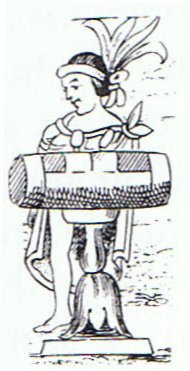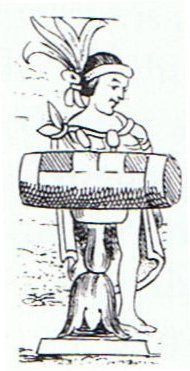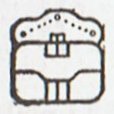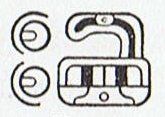|
ADDENDA
2. When I early on used much time and effort in order to create a Glyph Catalogue - possible to access from Level 2 - I decided to leave aside what looked like faintly drawn full stops, because this type of sign, although clearly carrying meaning, did not look like a glyph. When reading the calendar for the week, though, it ought to be commented upon. Because I can without much effort detect such small dots in e.g. these glyphs:
Especially noteworthy is the dot at the throat of the 'One-Leg' figure (Hb9-52), because here the dot has been drawn in the inside instead of outside in front - which is a very strong sign. The Mayas saw time running from right to left and therefore this lady, when reversed, could be conceptually equivalent to One-Leg in Hb9-52:
... The tun glyph was identified as a
wooden drum by Brinton ... and Marshal H. Saville
immediately accepted it ... [the figure below] shows the
Aztec drum representation relied on by Brinton to
demonstrate his point. It was not then known that an
ancestral Mayan word for drum was *tun: Yucatec
tunkul 'divine drum' (?); Quiche tun 'hollow log
drum'; Chorti tun 'hollow log drum' ...
... The [tun]
glyph is nearly the
same as that for the
month Pax ...
except that the top
part of the latter
is split or divided
by two curving
lines. Brinton,
without referring to
the Pax
glyph, identified
the tun glyph
as the drum called
in Yucatec pax
che (pax
'musical
instrument'; che
< *te
'wooden). Yucatec
pax means
'broken,
disappeared', and
Quiche paxih
means, among other
things, 'split,
divide, break,
separate'. It would
seem that the
dividing lines on
the Pax glyph
may have been used
as a semantic/
phonetic
determinative
indicating that the
drum should be read
pax, not
tun ... Thus,
one may expect that
this glyph was used
elsewhere meaning
'to break' and
possibly for
'medicine' (Yuc.
pax, Tzel., Tzo.
pox) ... It
should be added that
tun was also
the period of 18
months, or 360 days
... |
||||||||||||||||||||||||||||||||















